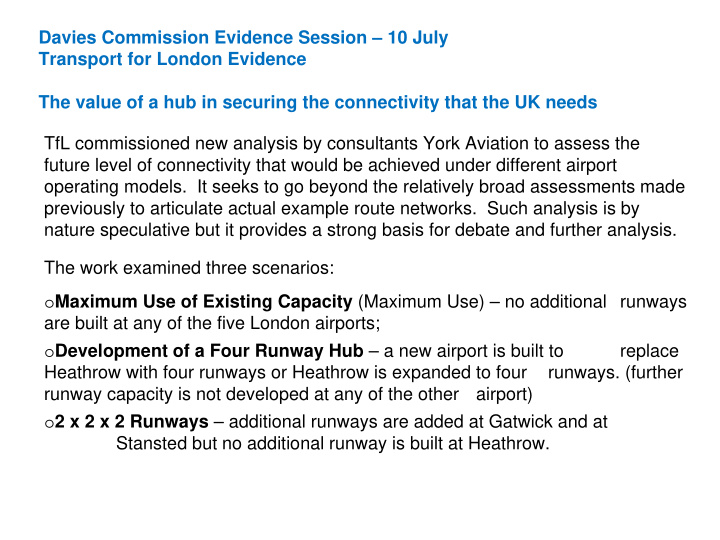



Davies Commission Evidence Session – 10 July Transport for London Evidence The value of a hub in securing the connectivity that the UK needs TfL commissioned new analysis by consultants York Aviation to assess the future level of connectivity that would be achieved under different airport operating models. It seeks to go beyond the relatively broad assessments made previously to articulate actual example route networks. Such analysis is by nature speculative but it provides a strong basis for debate and further analysis. The work examined three scenarios: o Maximum Use of Existing Capacity (Maximum Use) – no additional runways are built at any of the five London airports; o Development of a Four Runway Hub – a new airport is built to replace Heathrow with four runways or Heathrow is expanded to four runways. (further runway capacity is not developed at any of the other airport) o 2 x 2 x 2 Runways – additional runways are added at Gatwick and at Stansted but no additional runway is built at Heathrow.
Davies Commission Evidence Session – 10 July Transport for London Evidence The analysis uses a systematic approach. It makes best use of existing evidence and data, while recognising the changing landscape of the world economy. It is supported by a number of underlying principles: o Grounded in existing passenger flows (existing CAA data) o Quantum of future demand within the parameters of DfT 2013 forecasts o Constraining LHR growth will mean a loss of hub function and a greater reliance on point to point demand o High value services will displace low value services (value is not revenue but value to airlines as a whole) o A cascade dynamic will operate in London o Sheer economic size of destination cities will not be a guarantee of a new service – airlines will seek to serve cities efficiently, focusing on lead cities in geographic clusters, particularly for long haul destinations
Davies Commission Evidence Session – 10 July Transport for London Evidence The broad methodological approach was as follows: GROW KNOWN ORIGIN / DESTINATION MARKET DEMAND TO 2050 USING ADJUSTED DFT FORECASTS FREQUENCY TO NEW FREQUENCY TO NEW DESTINATIONS WITH NO DESTINATIONS BASED CURRENT FLOWS ON KNOWN FLOWS & BASED ON CITY SIZE / PRO-RATA INCREASE IN FREQUENCIES ON DEMAND THRESHOLDS ECONOMIC EXISTING DESTINATIONS IN 2050 (ADJUSTED FOR IMPORTANCE AIRCRAFT SIZE GROWTH) FREQUENCIES TO NEW DESTINATIONS IN 2050 UNCONSTRAINED DESTINATIONS & FREQUENCIES IN 2050 APPLY CAPACITY CONSTRAINT COSTS (IF NECESSARY) CASCADE DESTINATIONS & FREQUENCIES TO ALTERNATE AIRPORTS
Davies Commission Evidence Session – 10 July Transport for London Evidence Results – Destinations and Weekly Frequencies HUB airport Current Maximum 2 ‐ 2 ‐ 2 4 ‐ runway hub use 2013 2050 2050 2050 China 3 6 6 14 South America 3 5 5 13 USA 22 23 23 33 Domestic 7 6 6 16 Worldwide 171 140 140 299 Total 4,714 4,850 4,850 9,226 frequencies The 4-runway hub delivers substantially more connectivity at London’s main airport. More than twice the number of destinations are offered than in the other future scenarios.
Davies Commission Evidence Session – 10 July Transport for London Evidence Results – Destinations and Weekly Frequencies LONDON Current Maximum 2 ‐ 2 ‐ 2 4 ‐ runway hub system use 2013 2050 2050 2050 China 3 6 6 14 South America 3 5 5 13 USA 26 26 26 36 Domestic 15 13 14 17 Worldwide 385 322 358 435 Total 10,133 12,201 15,598 16,576 frequencies Across the London airports, the connectivity value of a 4-runway hub airport is also clear. There are substantially more destinations served (21% more than the next best future option) and more weekly frequencies realised.
Even items you would have thought were uncomplicated… • A Nissan car seat has 95 different parts arriving from 17 suppliers (in the UK, Belgium, China, Germany, Poland, Romania and Spain) • Components may travel by air, sea, rail and truck depending on the weight/value and type of operation (e.g. just ‐ in ‐ time) • The final assembled product is less likely to travel by air, but many components may arrive by air
Recommend
More recommend